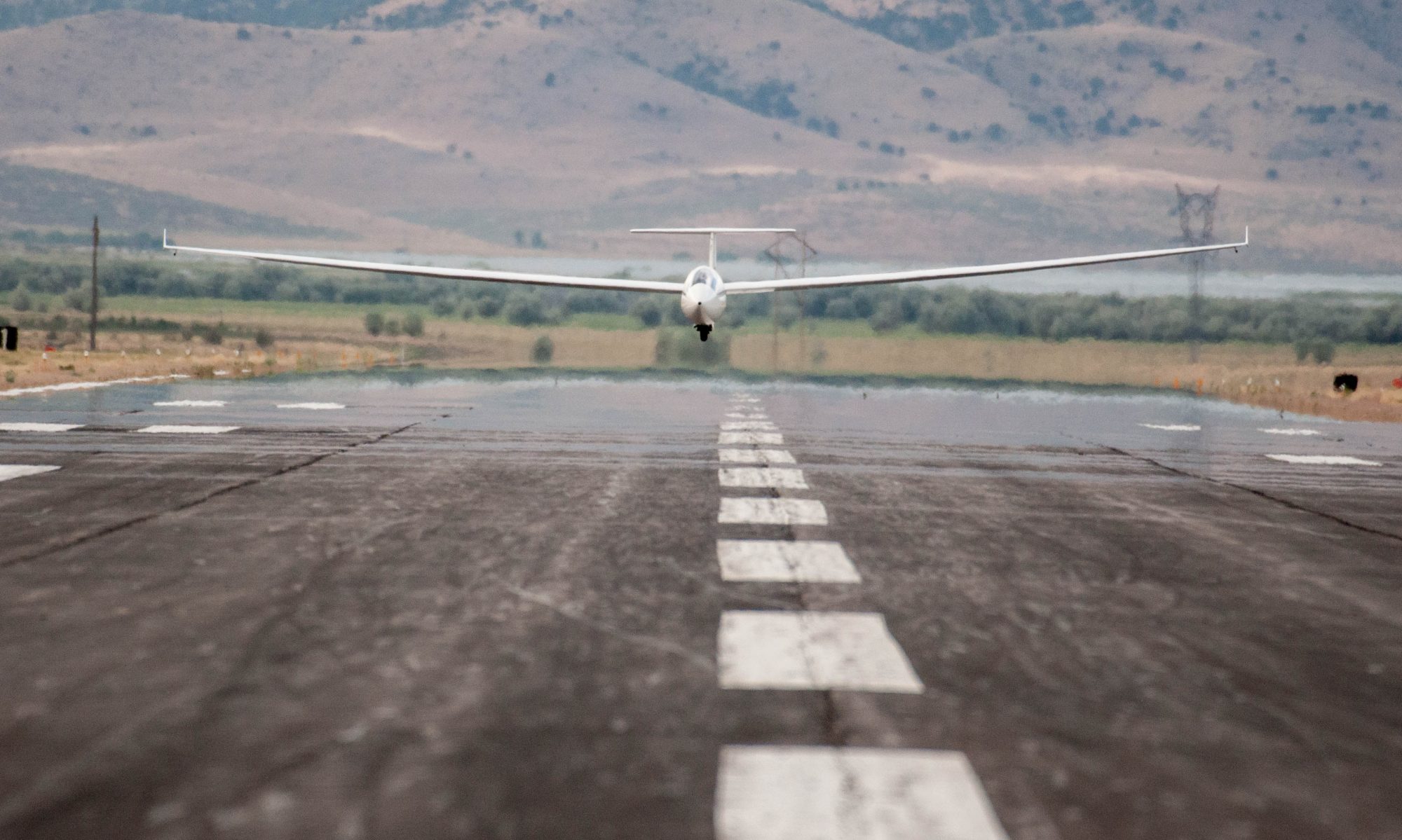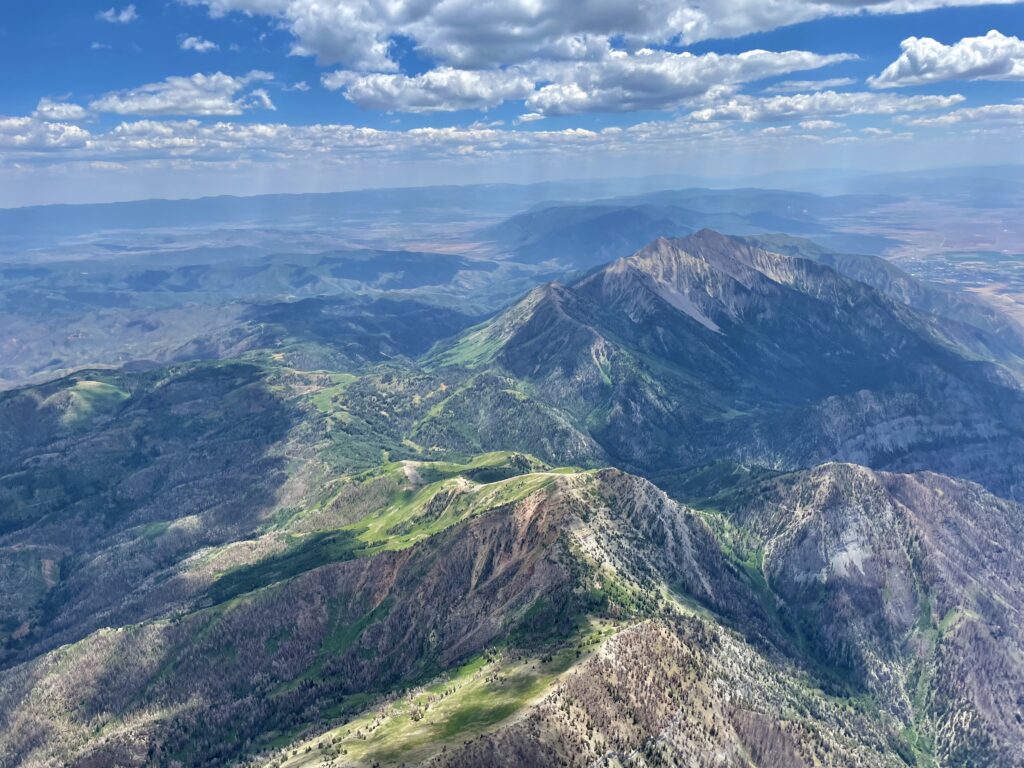Everyone can follow cloud streets that perfectly set up along the major mountain ranges. Today, Day 8 of the 18m Nationals, was not like that. We were given an Assigned Area Task (AAT) with turn areas at Huntington Muni (20km), Cricket Mountains (30km), and Table Mountain (30km), then back to Nephi.
The task required us to cross the mountains and valleys back and forth. There were a lot of decisions to make and a number of traps to avoid. Thermal conditions were very strong, and cloud bases were well above the legal maximum of 17,500 ft, but there was much more wind to contend with than in the past few days. We saw west-south westerly winds of close to 30 kts today in some parts of the task area.
The launch was once again a problem. This time it was the changing wind on the ground. I was among the early starters launching at 13:21 and had no problem climbing up to 16,000 feet right off tow. Then the winds picked up and the launch had to be paused. Then the wind direction changed and the remaining gliders had to be moved to the other end of the runway. This is lovingly called the elephant walk. I’m not sure whether the elephants are the pilots or the gliders but you should know that there is no walking involved because everyone can just tow their glider with their air conditioned vehicle.
But the delay was substantial nonetheless.
The start gate eventually opened at 15:33. I had already been in the air by more than two hours and had flown well over 200 km by that time. But now the race was on and the task distance was another 432-718 km, to be flown in no less than three hours.
Everyone quickly tried to climb up to the legal maximum before crossing the start gate. I went out as soon as I could, which was at 15:53. Kind of late to start a task with a nominal distance of 573 km. But there we were. The forecast predicted an abrupt end to soaring conditions around 7pm, so getting around the course as fast as possible was imperative.
I had a pretty good start with quick climbs on on back side of Mt Nebo and the edge of the Wasatch Plateau and quickly made it to the edge of the first turn area. I watched the gaggle continue to go deeper into the cylinder and decided to turn early. Time was of the essence. In the miraculous event of being undertime, I would have plenty of opportunity to go deeper in turn areas two or three.
I headed for a great looking cloud to get high enough to cross the plateau against a 20 kt headwind. Unfortunately, the cloud dissolved in front of my eyes and I had to look for a climb in the blue. As I got lower the lee-side effect of the plateau became more and more pronounced and I literally got washed out while I was looking for a climb in the blue. Fortunately I found an eight knotter in a wind protected bowl that took me back up to 16,000 feet – enough to safely cross the rising terrain of the plateau, even against the stiff head wind.
Once back on the west side, it was just a question of picking the right lines to get to the second turn area. There were valleys and ridges to cross into the wind and I wanted to stay high to be protected against further lee-side sink.
The clouds weren’t perfectly aligned with the course but 30-40 degree course deviations are an easy tradeoff if you can fly in lift. I tanked up on the luv side of the Pavani range in an 11 knot climb before heading out over the desert.
There were some good big clouds ahead and I have become much better at figuring out exactly where under these clouds the best lift is to be found.
Another 8 knot climb got me to the turn area. Tactically it would have been smarter to push all the way to the turn area and take the climb on the downwind leg but I was too chicken to risk getting low over the desert and took the climb while going into the wind.
I just nicked the turn area because my computer showed about 1 hour of over time and back-tracked to a nice looking cloud line that went to the west side of Mt Delano, the western edge of the last turn area.
It was already past 6pm and I noticed that the cloud cover was already diminishing suggesting a weakening of the soaring conditions. Late in the day it is often best to stay high, so I down-shifted and flew 90 kts instead of 105. Good thing because I did not find any good climb southwest of Mt Delano. I took a 4 knotter to get back to 16,000 and nicked the third turn area on the west side.
It was 18:30. I had another 150 km to go to the finish and was in need of at least two more climbs. I looked at the Flarm screen and noticed some gliders going up at 9 kts some 10 km ahead. Fortunately I got there early enough to join then and climbed right back to 17,300 feet.
I was still about 2500 feet low on Final Glide at MC 4 and the clouds ahead were quickly disappearing. But somewhere along the western edge of the Pavani Range ought to be another climb… I downshifted further to about 80-85 knots and tested the air along the upwind side of the mountains. Once or twice I stopped for a 2-3 kt climb that quickly disappeared.
A glider ahead of me got into sink and I diverted upwind and found much better air, allowing me to cruise at a glide ratio of 50:1. Gradually I made it above Final Glide Altitude and just felt my way towards the finish, increasing my speed as the glide ratio improved.
I crossed the finish line at 19:23 with a few hundred feet to spare for an average task speed of 139 kph, which put me in 18th place for the day, earning 887 contest points.
Overall, I moved up to 22nd place in the contest. This sounds far back but it’s still ahead of some excellent pilots, even some who have won National Championship titles before. This has been a very high-caliber contest with most if not all the very best US pilots attending and I am quite pleased with my overall performance.
Today’s winner was Gary Ittner (157 kph) ahead of David Coggins (156 kph) and Thomas Greenhill (153 kph). The new US National Champion in 18m is Sean Fidler (despite having a challenging day and flying the same speed as myself) with John Seaborn (the defending National Champion) in second, and Andy Blackburn in third. John Seaborn won the trophy for the fastest contest flight for yesterday’s performance at 190 kph!
These were amazing Championships with blazingly fast flight. On six of the eight contest days the winner’s speed exceeded 100 mph.
I have learned a lot and am pleased to have safely made it around all contest tasks without taking undue risks.
Flight Trace on WeGlide: https://www.weglide.org/flight/81984
Flight Trace on OLC:https://www.onlinecontest.org/…/gliding/flightinfo.html…
Contest Results: https://members.ssa.org/ContestResults.asp?contestId=2486&ContestDetailId=24458&ContestName=2021+18%2DMeter+Nationals+at+Nephi&ContestDate=7/8/2021&ResultsUpdate=True
The overall contest results for all eight contest days are here: https://members.ssa.org/ContestResults.asp?contestId=2486&ContestDetailId=24459&ContestName=2021+18%2DMeter+Nationals+at+Nephi



Clemons, pilots such as you have my utmost respect and awe. This contest journal gave me a good taste of your experience. Thanks!!!